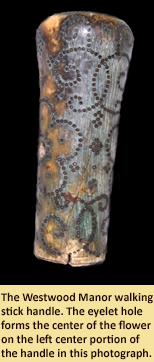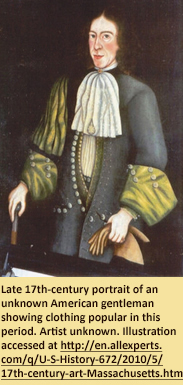Maryland Archaeological Conservation Laboratory
Main_Content
Curator's Choice 2011
Ivory and Silver Walking Stick Handle
May 2011
By Patricia Samford, MAC Lab Director
 In the late 17th and early 18th centuries, the Zekiah Swamp was a sparsely settled frontier region on Maryland's western shore in what is today Charles County. In the mid-1990s, a late 17th-century plantation known as Westwood Manor (18CH621) was discovered during modern house construction. Archaeological and documentary evidence suggests the house at Westwood was an elite residence with a porch tower, brick chimneys, plastered walls, and glazed windows (Chaney n.d.) and was owned by planter John Bayne and his wife Anne between 1688 and 1702 (King 2010:7-8). At the time of his death in 1701, Bayne owned nearly 2,500 acres of land and his real and personal estate placed him economically within the top tier of the population in southern Maryland (Carr, Menard and Walsh 1991).
In the late 17th and early 18th centuries, the Zekiah Swamp was a sparsely settled frontier region on Maryland's western shore in what is today Charles County. In the mid-1990s, a late 17th-century plantation known as Westwood Manor (18CH621) was discovered during modern house construction. Archaeological and documentary evidence suggests the house at Westwood was an elite residence with a porch tower, brick chimneys, plastered walls, and glazed windows (Chaney n.d.) and was owned by planter John Bayne and his wife Anne between 1688 and 1702 (King 2010:7-8). At the time of his death in 1701, Bayne owned nearly 2,500 acres of land and his real and personal estate placed him economically within the top tier of the population in southern Maryland (Carr, Menard and Walsh 1991).
 Included among the Bayne household artifacts found at Westwood Manor was a decorated ivory walking stick handle. The bell-shaped knob was inlaid with hollow silver pins in an elaborate design of overlapping C-scrolls and flowers. This decorative technique, known as "piquework" was extremely fashionable between the mid-17th century and the early decades of the 18th century (De Vecchio 1994:23). Surviving dated canes date between 1667 and 1717 (Klever 1996:82; Snyder 1993:4), although most seem to cluster in the 1670s to 1690s period. These canes are generally around three feet in length, with shafts of exotic foreign woods, like Malaysian rattan, often joined to the knob with a silver collar. The Westwood Manor cane contained an eyelet hole, through which was passed a cord for hanging the cane from the wrist (Snyder 1993:11). Piquework walking sticks were made in France and England; the use of silver rather than gold pins indicates that the Westwood cane was of English manufacture (Kadri 2011). Lists of store goods stocked by Maryland merchants during this period
Included among the Bayne household artifacts found at Westwood Manor was a decorated ivory walking stick handle. The bell-shaped knob was inlaid with hollow silver pins in an elaborate design of overlapping C-scrolls and flowers. This decorative technique, known as "piquework" was extremely fashionable between the mid-17th century and the early decades of the 18th century (De Vecchio 1994:23). Surviving dated canes date between 1667 and 1717 (Klever 1996:82; Snyder 1993:4), although most seem to cluster in the 1670s to 1690s period. These canes are generally around three feet in length, with shafts of exotic foreign woods, like Malaysian rattan, often joined to the knob with a silver collar. The Westwood Manor cane contained an eyelet hole, through which was passed a cord for hanging the cane from the wrist (Snyder 1993:11). Piquework walking sticks were made in France and England; the use of silver rather than gold pins indicates that the Westwood cane was of English manufacture (Kadri 2011). Lists of store goods stocked by Maryland merchants during this period  do not list walking sticks; John Bayne would have acquired this object either during a trip to England or through a special order with an agent.
do not list walking sticks; John Bayne would have acquired this object either during a trip to England or through a special order with an agent.
Before the turn of the fifteenth century, walking sticks served either a purely functional purpose as an aid to walking or as a symbol of authority (De Vecchio 1994:13-15). Their transformation into elegant fashion accessories and statements of power and status began in Europe and continued over the next several hundred years (Snyder 2004:49). The same connotations of status and power held true for the American colonies as well. While Bayne certainly could have used his stick as a purely functional walking aid, the elaborately decorated stick would have also been an impressive fashion accessory and very much at home as a prop in the social setting of a parlor or a tavern, or wielded as its owner made an appearance in front of the Maryland Assembly. The polished white of the ivory knob set with flashing silver pins would have provided a striking contrast to the deep orange patina of the rattan shaft. This walking stick, used in combination with stylish clothing in expensive fabrics, wigs and jewelry, would have confirmed John Bayne as a gentleman to anyone who saw him.
Despite the semi-isolated nature of the Zekiah Swamp at the end of the 17th century, its wealthy inhabitants were living elite lifestyles in which their social and economic standing was readily visible through their homes and furnishings, as well as their clothing and accessories. Fashion trends gleaned from England and Europe were put to work along the borders of Maryland’s colony in the late 17th century and used by the social elite to signal their authority and status.
| References |
|
| Carr, Lois Green, Russell R. Menard and Lorena S. Walsh |
| 1991 |
Robert Cole’s World; Agriculture and Society in Early Maryland. University of North Carolina Press, Chapel Hill. |
|
| Chaney, Edward |
| 1996 |
Harrison's Westwood Manor—Summary Report. Unpublished report on file at the Maryland Archaeological Conservation Laboratory. |
|
| De Vecchi, Paolo |
| 1994 |
Walking Sticks. BE-MA, Milan, Italy. |
|
| Kadri, Youssef |
| 2011 |
Cane Quest. http://www.canequest.com/pique.asp. |
|
| King, Julia, editor |
| 2010 |
The Westwood Manor Archaeological Collection: Preliminary Interpretations. Report prepared by the Archaeology Practicum Class, St. Mary's College of Maryland. |
|
| Klever, Ulrich |
| 1996 |
Walkingsticks: Accessory, Tool, and Symbol. Schiffer Publications, Atglen, PA. |
|
| Snyder, Jeffrey B. |
| 1993 |
Canes from the Seventeenth to the Twentieth Century. Schiffer Publications, Atglen, PA. |
| 2004 |
Canes and Walking Sticks; A Stroll Through Time and Place. Schiffer Publications, Atglen, PA. |
|